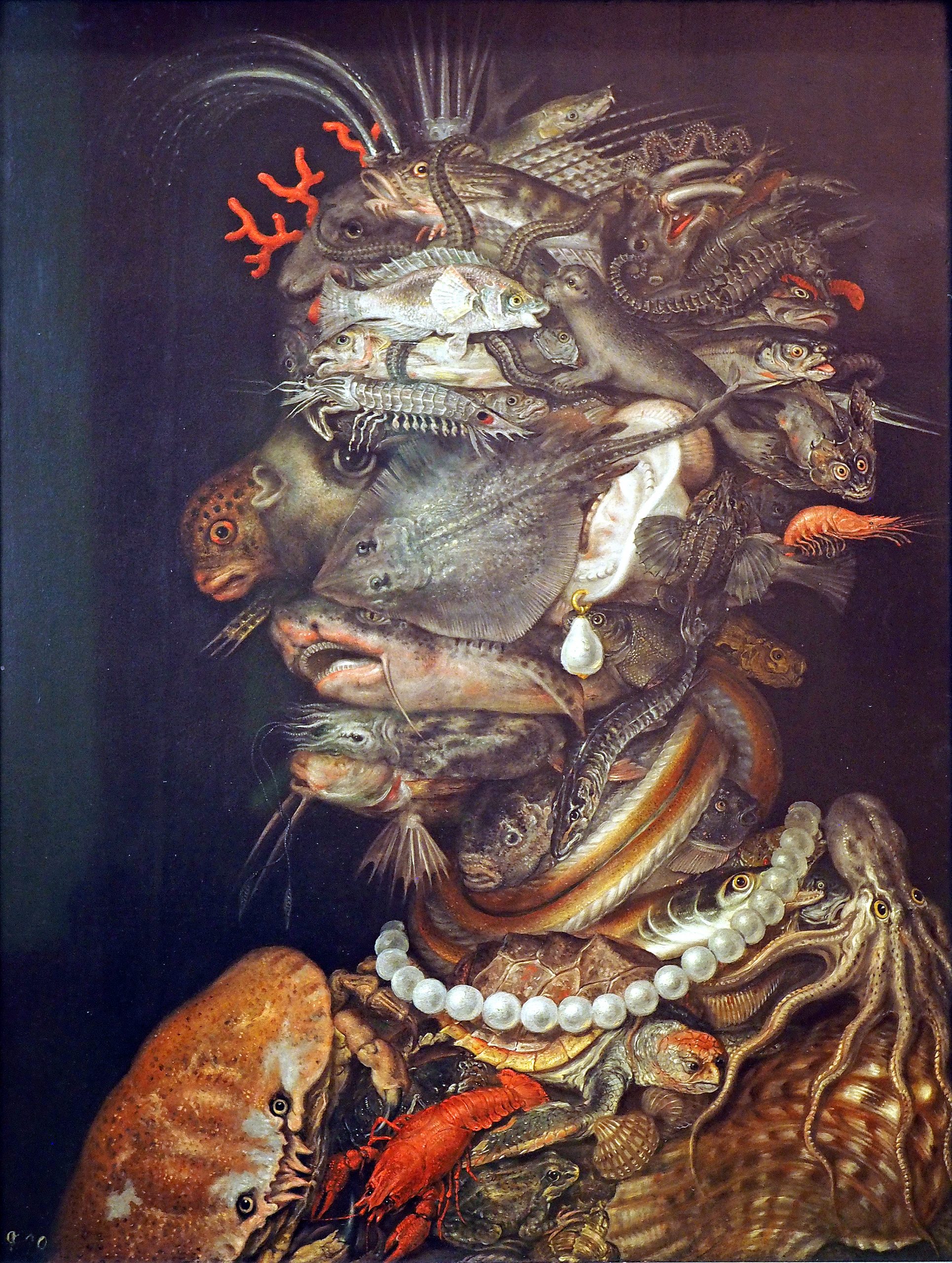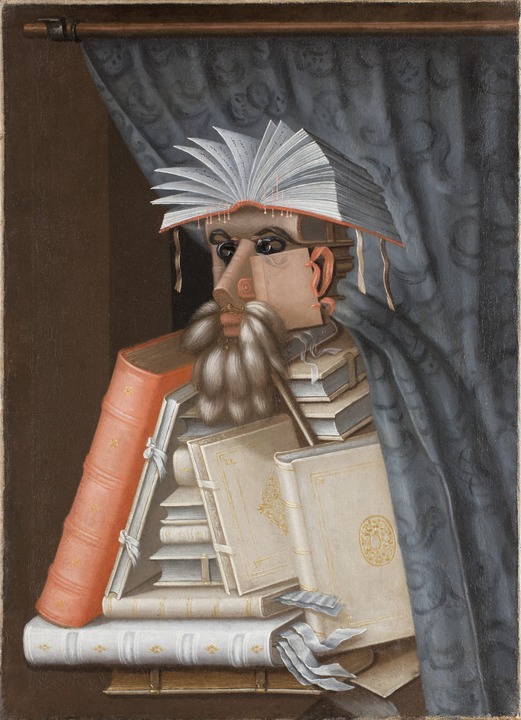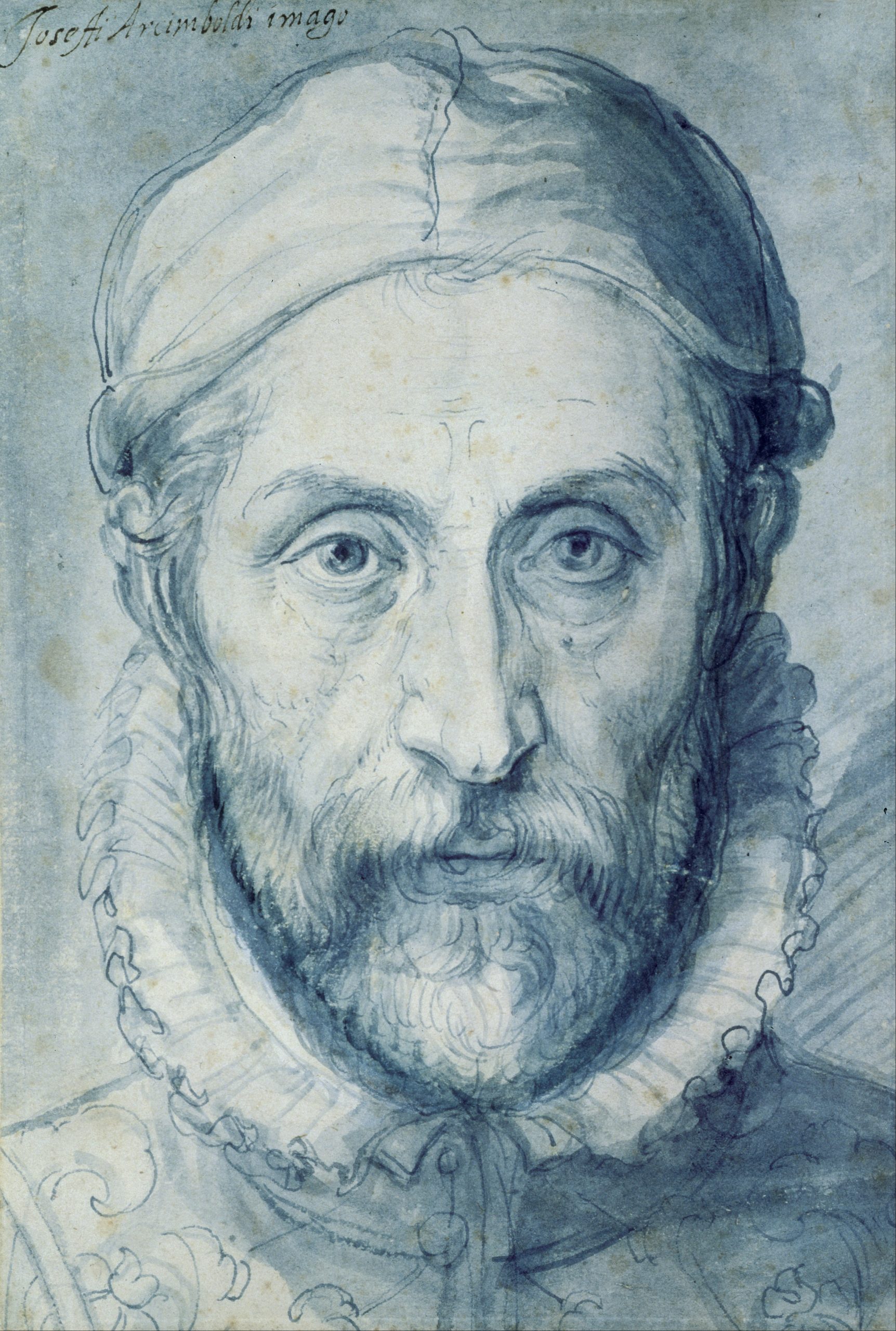Giuseppe Arcimboldo
Water is on display at Cromer Eye Care on High Street
The Librarian is at Hansells on Church Street
Giuseppe Arcimboldo (1527-1593) was an Italian painter best known today for creating imaginative portrait heads made entirely of objects such as fruits, vegetables, flowers, fish and books. However, these works form a distinct category from his other productions. He was a conventional court painter of portraits for three Holy Roman emperors in Vienna and Prague, also producing religious subjects and, among other things, a series of coloured drawings of exotic animals in the imperial menagerie.
Known as a 16th-century Mannerist he aimed to show close relationships between human and nature by his appreciation of nature through his portraits. He specialized in grotesque symbolical compositions of fruits, animals, landscapes, or various inanimate objects arranged into human forms.
Art critics debate whether these paintings were whimsical or the product of a deranged mind. A majority of scholars hold to the view, however, that given the Renaissance fascination with riddles, puzzles, and the bizarre, Arcimboldo, far from being mentally imbalanced, catered to the taste of his times.
HIS LEGACY
The works of Arcimboldo, especially his multiple images and visual puns, were rediscovered in the early 20th century by Surrealist artists such as Salvador Dalí. The exhibition entitled “The Arcimboldo Effect: Transformations of the face from the 16th to the 20th Century” in Venice
(1987) includes numerous ‘double meaning’ paintings. His influence can be seen in the work of many artists as well as in the films of Jan Švankmajer. The painting “Water” was used as the cover of the 1975 album Masque by prog rock band Kansas, and was also on the cover of the 1977 Paladin edition of Thomas Szasz’s The Myth of Mental Illness.

THE FOUR SEASONS AND THE FOUR ELEMENTS
At a distance, his portraits looked like normal human portraits. However, individual objects in each portrait were actually overlapped together to make various anatomical shapes of a human. They were carefully constructed by his imagination. The assembled objects in each portrait were not random: each was related by characterization.
The Four Seasons is his best known series.

- “Spring” is composed mainly of flowers, the skin of the face and lips are rose petals and buds, the hair is a colourful bouquet, the eyes are belladonna berries. A daisy necklace adorns the neck, while the body is covered in a vast jungle of leaves of different shapes.
- “Summer” is made up from fruits and vegetables. Cherries adorn the border of her hair and also make up her upper lip; the cheek is made of a peach, the nose of a cucumber, the ear is an aubergine and her eyebrow is a piece of wheat. Her dress is made of straw and an artichoke decorates her chest.
- “Autumn” is represented by fruit and vegetables bursting from a partially destroyed barrel. His face is made of apples and pears, his chin is a pomegranate, the ear is a mushroom with a fig-shaped earring. The lips and mouth are made of chestnuts, bunches of grapes depict his hair, and his hat is a pumpkin.
- “Winter” is an old man whose skin has wrinkles and abrasions represented by a gnarled tree trunk, his thin beard is composed of small roots and the mouth is two mushrooms. His hair is a tangle of branches and his bare figure is enlivened only by the lemon and orange, hanging from the chest.
The Four Elements is a series of four oil paintings created in 1566, for Maximillian III, Holy Roman Emperor. The paintings depict human faces in profile made up from different animals and objects. The series attempts to express the creation of harmony from chaos by the careful arrangement of the wild animals to form portraits whilst also praising Maximilian by suggesting that he is a ruler who controls even the four primal elements.

- “Water” features a chaotic mess of sea creatures to create a woman’s face. Her breast plate is a crab, turtle and lobster along with an octopus on her shoulder. The animals that make up her head are obscure but a clear crown is formed by the spines on the back of a fish and long pieces of coral. A pearl necklace lies across her neck framing her face and completing the pattern of order from confusion. She also wears a pearl earring.
- “Fire” is formed flint and steel for the nose and ear, burning wood creates a crown of glowing hair and guns create the main part of the body. The torso is decorated by The Order of the Golden Fleece and the double headed eagle, a symbol of the Holy Roman Empire. The two large cannons refer to the strength of the Habsburg armies in their ongoing war with the Turks.
- “Air” displays a cornucopia of small birds which create a slender male face. The body is formed by a peacock; the goatee is a tail of a pheasant, and a duck forms the eyelids. The eagle and peacock are symbols of the Habsburg dynasty.
- “Earth” is formed by skilfully blended land animals curving together to create a strong, thick face. Antlered creatures surround the head like a crown. An elephant creates the cheek and ear while a wolf eating a mouse forms the eyelid and pupil. A full cow represents the neck and, the lion and the fleece are references to the Habsburg dynasty.

THE LIBRARIAN (1566)
“The Librarian” is thought to be a portrait of Wolfgang Lazius, a humanist and historian who served Holy Roman Emperors of the House of Habsburg. It is one his early works from a series of portraits depicting members of the Emperor’s entourage, also in the series is “The Jurist” and “the chef”. Arcimboldo used objects that signified the book culture at that time. Animal tails, which became the beard of the portrait, were used as dusters.
Not only did Arcimboldo use fruits, vegetables, plants, and animals as objects for the compilations in his paintings, he also used inanimate objects such as books and papers. The Librarian is one such painting. In this painting, Arcimboldo’s subject is obvious: a lover of books made up out of books. This is an example of the painter’s ability to be less literal. Whereas in other paintings, he shaped singular pieces of fruit or meat into the eyes, nose, or curve of the chin, in this painting, the pile of books only resembles a person, and upon closer inspection, the features become less clear. This is an example of Arcimboldo’s great talent of disguising his objects into the form of a person, or as in this case, disguising his person into the form of his objects.


